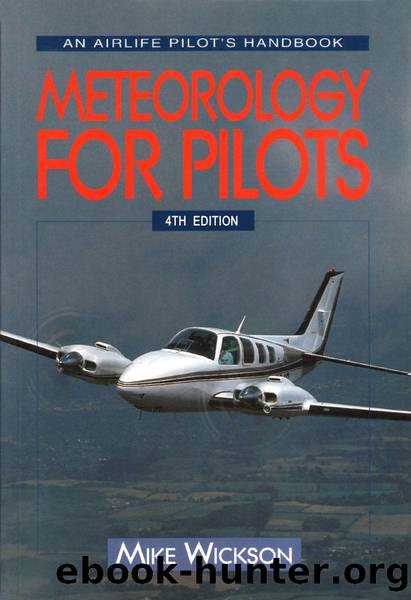Meteorology for Pilots, 4th Edition by Mike Wickson

Author:Mike Wickson
Language: eng
Format: epub
ISBN: 9781847979612
Publisher: The Crowood Press
Radiosonde
The radiosonde is used to provide upper air information. This is used to produce constant pressure charts. It in fact produces data on a 12-hour interval basis of pressure temperature and humidity. The radiosonde comprises a small radio transmitter suspended from a hydrogen balloon which emits a carrier wave. The carrier is modulated by introducing in turn, three sensing elements into the carrier wave circuit. After release from the ground the sensors continuously measure pressure, temperature and humidity. The balloon takes the device up to some 150,000 ft (46 km) transmitting the whole time. Around this level the balloon bursts and the radiosonde then breaks up as it falls into denser air.
Transmissions are received at a ground station and decoded into normal values. The sites from which 12-hour releases are made include ships and ground stations. In the UK there are nine ground sites, whereas in a large country such as the USA there are hundreds of sites.
During operation the radiosondes are tracked by radar enabling upper winds to be measured and height to be monitored. These devices are not a danger to aircraft but sometimes they can be seen ascending within sight of an aircraft. A drawing of a radiosonde is at Figure 15.3.
Download
This site does not store any files on its server. We only index and link to content provided by other sites. Please contact the content providers to delete copyright contents if any and email us, we'll remove relevant links or contents immediately.
What's Done in Darkness by Kayla Perrin(25493)
Shot Through the Heart: DI Grace Fisher 2 by Isabelle Grey(18209)
Shot Through the Heart by Mercy Celeste(18153)
The Fifty Shades Trilogy & Grey by E L James(17768)
The 3rd Cycle of the Betrayed Series Collection: Extremely Controversial Historical Thrillers (Betrayed Series Boxed set) by McCray Carolyn(13182)
The Subtle Art of Not Giving a F*ck by Mark Manson(12898)
Scorched Earth by Nick Kyme(11823)
Stepbrother Stories 2 - 21 Taboo Story Collection (Brother Sister Stepbrother Stepsister Taboo Pseudo Incest Family Virgin Creampie Pregnant Forced Pregnancy Breeding) by Roxi Harding(11019)
Drei Generationen auf dem Jakobsweg by Stein Pia(10211)
Suna by Ziefle Pia(10179)
Scythe by Neal Shusterman(9251)
International Relations from the Global South; Worlds of Difference; First Edition by Arlene B. Tickner & Karen Smith(8600)
Successful Proposal Strategies for Small Businesses: Using Knowledge Management ot Win Govenment, Private Sector, and International Contracts 3rd Edition by Robert Frey(8407)
This is Going to Hurt by Adam Kay(7682)
Dirty Filthy Fix: A Fixed Trilogy Novella by Laurelin Paige(6445)
He Loves Me...KNOT by RC Boldt(5798)
How to Make Love to a Negro Without Getting Tired by Dany LaFerrière(5369)
Interdimensional Brothel by F4U(5299)
Thankful For Her by Alexa Riley(5149)
